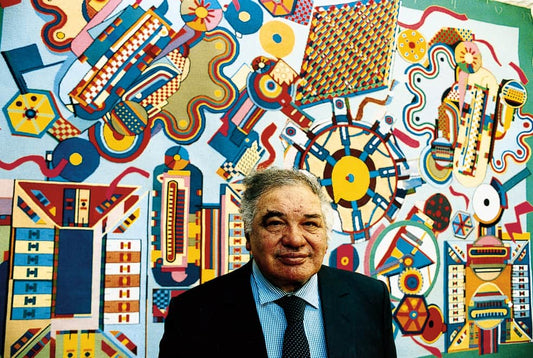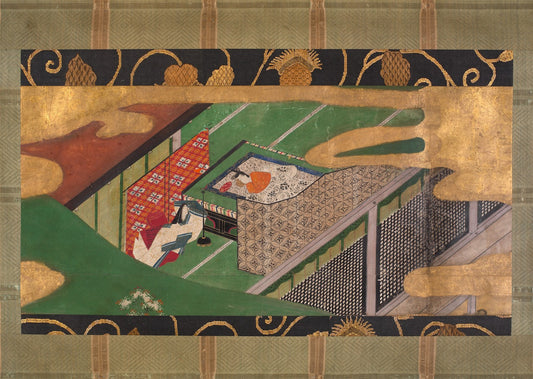Feature image: Installation view of ” Walk on the Wild Side: ‘70s New York in the Norman E. Fisher Collection at MOCA Jacksonville.” Photo by Doug Eng.
Norman E. Fisher: A Walk on the Wild Side
In February 2024, I got to see the exhibition of A Walk on the Wild Side: ‘70s New York in the Norman E. Fisher Collection at the Museum of Contemporary Art (MOCA) in Jacksonville, Florida. The exhibition features almost 700 pieces of art from various artists from New York City. The entirety of the exhibit occupies the second and third-floor galleries of MOCA. Through the artwork, the exhibition explores “the dynamic culture of New York in the 1970s that spurred a decade of collaboration and innovation between artists working in a variety of genres.” This exhibit is one of many this year to celebrate MOCA’s 100th anniversary, and as a viewer, I felt I was transported back in time to the 1970s.

A Walk on the Wild Side: ‘70s New York in the Norman E. Fisher Collection opened on January 18 th, 2024, and will be showcased until July 14 th, 2024. Norman E. Fisher’s collection consisted of many art mediums by various artists, such as paintings, sculptures, dancing, music, film, and poetry. It was a melting pot of contemporary art from the 1970s, well before my time, so I had to learn more. According to MOCA, in New York City during the 1970s, “It was a time when artists broke down the barriers between different art forms and collaborated with each other in newfound and innovative ways.” Norman E. Fisher wanted to capture New York artists' extraordinary work when art was expanding in different styles.
In 1979, the Norman E. Fisher Collection was donated to MOCA Jax by Norman’s family. This was two years after his death, and MOCA Jax was then known as the Jacksonville Art Museum. Norman was born in Jacksonville, Florida, on July 31, 1938, and died on April 9 th, 1977, in Los Angeles, California. He was a native of Jacksonville, Florida, who immersed himself in 1970s New York City art. While in New York, Norman befriended all kinds of artists: writers, singers, and musicians, who were later featured in his collection of art.

The exhibit at MOCA enhanced how Norman shared a love and passion for art at a young age. Before he met with artists, he had gone to college at NYU, where he studied the arts. However, as an adult, the exert Portrait of Norman said, “He was not interested in particular movements or ways of working, but appeared fascinated by the act of creation itself - how it develops and plays.” Norman wanted to see an artist’s process of their creation. So, in Manhattan, where Norman lived while in New York, he had an apartment on West 12th Street. Artists would meet Norman there to discuss and collaborate on art. According to MOCA, Norman’s apartment was “a salon, known as “Norman’s” that would bring together creatives of all genres.”
According to the See Great Art website, Norman has been compared to Gertrude Stein, “who famously brought together visual artists, poets, and writers in her home in Paris. In the same way, Fisher’s living room on West Twelfth Street in Manhattan became a gathering place – a salon– known as “Norman’s” that would bring together creatives of all genres.”
The Artists
The following artists below met with Norman during the 1970s. These artists were trying to find their artistic voice through their work. Thus, each produced a different kind of art that was far from traditional oil on canvas. Although there were over 700 pieces, this article acknowledges six featured artists from Norman’s collection.
Andy Warhol
Warhol was an American artist who lived from 1928 to 1987. MOCA featured a single piece of his artwork, Mick Jagger, 1975. Warhol worked with screen print on Arches Aquarelle paper. Mick Jagger's outcome is a framed portrait of blue, black, gold, and white colors from a paper courtesy of Charles Gilman. Portraits were Warhol’s specialty in art because he had done a portrait of Norman himself. Although his portrait of Norman wasn’t featured at the exhibition, Warhol took part in an additional series of portraits called Interview. He accomplished this along with John Wilcock. Four portraits from four volumes from February to December 1976 were on display.

Jeffery Lew
Lew is an American artist who was born in 1946, and he is still alive to this day. Interestingly, he worked with books from a library for his artwork. At MOCA, an entire wall was dedicated to Lew’s work. He takes the idea and imagery of books and libraries to another level. MOCA featured four pieces from Lew. Firstly, a framed picture of offset lithography was on paper, which read Jeffrey Lew Art Book Library. Next to this frame was a two-panel framed picture, Art Book lIbrary Statement, both covering a whole quote by Lew himself. A significant statement from the quote that explains Lew’s artistic motive is, “The reasons for using the book’s image is simply due to the fact that the book is the most viable form of communication…each of these books tells a story as any other book only they are ‘blank’ without any written word.” To Lew books are a form of communication which enables connections, voice, and most importantly - “ultimately energy.” So, Lew’s Book Articulations presented a bookshelf with a top and bottom shelf filled with ten books. However, these weren’t just any books. Lew was certain the books’ covers were a variety of different colors such as blue, red, brown, beige, metal, and white. In addition, this included a variety of book genres like fiction, reference, alarm, social register, romance, American Medical, Apolicital, and sculpture. Lew has created an art library through his selection of books to enhance communication within the art community further. To him, words are an art form.

Lawrence Weiner
He was an American artist who lived from 1942 to 2021. During the 70s, he created offset lithographs on paper for his artwork. Like Lew, he used words and literacy in his artwork on lithographs on paper. The only difference is Weiner focused on words specifically. His 1974 artwork is framed pictures of snippets of words With a Relation to the Various Manners of Placement and/ or Location, With a Relation to the Various Things Brought to Light, and (Often Found) Within the Context of Effectiveness. These titles of his artwork came from the poem's first line in the framed picture. The words discussed noise, effectiveness, coming into the light, and feelings of placement. The words offer insight into human emotions and experiences. Meanwhile, the only framed picture featuring people by Weiner is Above Below the Level of Water With a Probability of Flooding. Along with his words, he offers an image for his audience of a family standing by a body of water. His viewers don’t have to use their imagination here, unlike his other featured art.
William Wegman
He was an American artist within Norman’s collection who focused on photography, specifically black and white photography. Norman’s collection had two of his photography pieces, As a Joke, 1971, and Mistake Correction, 1975. Both of Wegamn’s photography pieces were silver gelatin prints. According to MOCA, “His pioneering photography and video work were concerned with language, humor, and communion, focusing on the concepts he could portray through the artwork to the viewer.” Like Lew, Wegman gave his portrayal of communication only through black and white photography with literal language and humor. Both of his pieces featured two- panels connected together. In As a Joke, 1971, Wegan photographed two men, one sitting down on a couch and another walking past him. The bottom of the panel reads, “As a Joke, He Put His T-Shirt on Backwards.” In the first picture, the men do not look at one another, but in the second picture, the man sitting down is looking at the man who’s just walked past him. Viewers can infer the man walking by had his shirt on backward, and the man sitting down saw. Secondly, in Mistake Correction, 1975, Wegman provides a headshot of a man who’s on the phone. Interestingly, Wegman plays with imagery in his pictures because in the first one, on the left-hand side, the man is holding the phone upside down. Then, in the second picture, on the right-hand side, he’s holding the phone up correctly. He corrected his mistake - savvy artist!
Robert Wilson
Robert Wilson is an American theater director and playwright who was born in 1941. Unlike the other artists featured in Norman’s collection. He collaborated with Phillip Glass, a composer, and created the cover of Einstein on the Beach, an opera. The exhibition held Wilson’s original and first edition sketches, Einstein on the Beach, Act 1, Scene 2A, Trial (Bed), 1976, and Einstein on the Beach, Knee Play 4, 1976, on display. Both were completed on paper using graphite, and the titles of the act, scene, and knee play helped with scene changes. Einstein on the Beach forced viewers to think and “challenged all ideas of what an opera should be.” According to MOCA, there was no formal narrative within the opera. Rather, the audience was faced with a variety of abstract elements such as numbers, solfege syllables, and poems by Christopher Knowles. Fortunately, Einstein on the Beach made its duet at the Metropolitan Opera House in November 1976. He featured music in his artwork, a sketch of Einstein on the Beach. He looked at musicians.

Joseph Kosuth
He was an American artist who aimed “to explore the nature of representation itself.” He had made a piece called Titled (A.A.I.A.I), which features the definition of the literal word “reproduce.” His idea behind the word “reproduce” was that it represented art in the 1970s. Artists reproduce art. As the definition reads, “to produce again; make, for, or bring into existence again or in some new way.” Kosuth’s artwork stood out to me the most because he used a single word from the dictionary. As a writer, words are my art form. So, his using a single word and claiming artists reproduce art is gold.

The featured artwork is from New York, which is what Norman E. Fisher collected. He had an eye for contemporary art in many different forms. Art was Fisher’s passion, and he wanted to share with everyone what he saw in New York. The artists in Norman’s collection were considered “wild” because they dared to step outside the box and create new art. They saw art in the ordinary and made it extraordinary. Thus, Norman was fascinated by their way of creating art. How did these artists create their work? So, to capture this creative light, he went to New York and saw it for himself while befriending artists. Norman’s collection hit me personally, being a native of Jacksonville and having never been to New York City. I am grateful that this exhibit gave me insight into the artwork in New York City.
©ArtRKL™️ LLC 2021-2024. All rights reserved. This material may not be published, broadcast, rewritten or redistributed. ArtRKL™️ and its underscore design indicate trademarks of ArtRKL™️ LLC and its subsidiaries.







